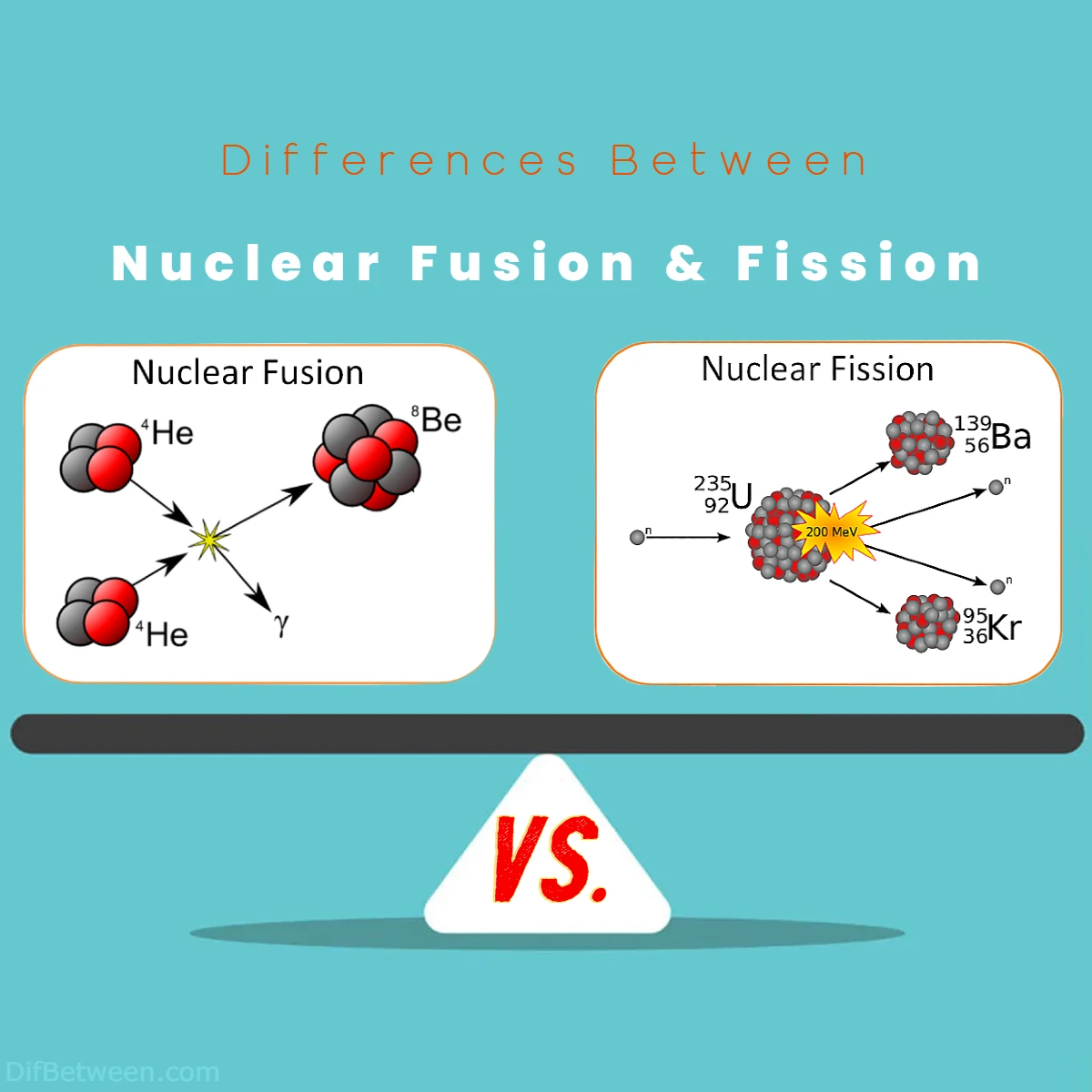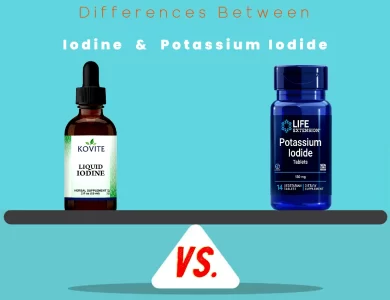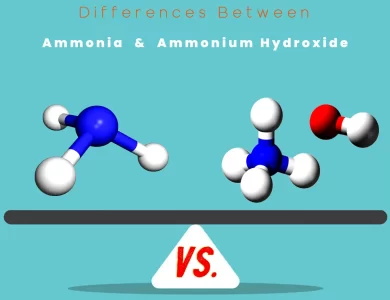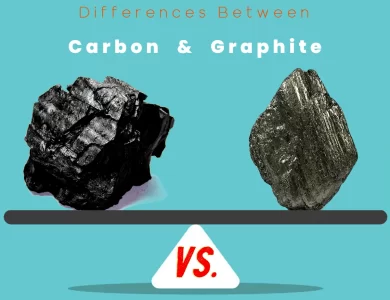
| Aspect | Nuclear Fusion | Nuclear Fission |
|---|---|---|
| Fuel | Hydrogen isotopes (deuterium, tritium) | Heavy nuclei (uranium, plutonium) |
| Reaction | Combining light nuclei | Splitting heavy nuclei |
| Energy Release | Extremely high | High |
| Waste Generation | Minimal | Significant |
| Radioactive Waste | Low radioactivity | High radioactivity |
| Fuel Availability | Abundant (hydrogen) | Limited (uranium, plutonium) |
| Temperature Required | Extremely high (millions of degrees) | High (millions of degrees) |
| Reaction Control | Challenging | Easier to control |
| Environmental Impact | Low greenhouse gas emissions | Concerns about radiation and safety |
| Safety Concerns | No risk of nuclear meltdown | Risk of nuclear meltdown |
| Current Applications | Experimental (e.g., ITER) | Commercial nuclear power plants |
| Future Potential | Promising, but research-intensive | Existing technology |
Nuclear fusion and fission are like two siblings, each with its unique traits and characteristics. These remarkable phenomena, reminiscent of the cosmic dance of stars, not only provide insights into the very essence of matter but also offer solutions to some of the most pressing challenges we face today.
Differences Between Nuclear Fusion and Fission
The main differences between Nuclear Fusion vs. Fission lie in their fundamental processes and outcomes. Nuclear Fusion involves the combination of light atomic nuclei, typically hydrogen isotopes, to create a heavier nucleus, releasing an exceptionally high amount of energy. On the other hand, Nuclear Fission entails the splitting of heavy atomic nuclei, such as uranium or plutonium, into smaller nuclei, also producing a substantial amount of energy. Fusion is characterized by minimal waste generation, low radioactivity, and an almost limitless fuel supply from hydrogen, while Fission generates significant radioactive waste and relies on limited fissile materials. Moreover, Fusion poses no risk of a nuclear meltdown, whereas Fission reactors carry a risk of such incidents. These distinctions highlight the unique attributes and challenges associated with each process.
The Basics: Understanding Nuclear Fusion and Fission
Before we delve into the distinctions, let’s take a moment to grasp the fundamental principles of nuclear fusion and fission.
Nuclear Fusion: The Power of the Sun
Nuclear fusion is the process that powers the stars, including our very own Sun. It occurs when two light atomic nuclei, typically isotopes of hydrogen, combine to form a heavier nucleus. This fusion process releases an enormous amount of energy, which is the result of the conversion of mass into energy, as described by Albert Einstein’s famous equation, E=mc².
In the context of nuclear fusion on Earth, the most promising reaction is the fusion of isotopes of hydrogen—deuterium (D) and tritium (T). When these two isotopes are brought together under extreme heat and pressure, they can fuse to form helium (He) and release a tremendous amount of energy, along with a neutron. This process replicates the energy generation mechanism of the stars, providing us with a nearly limitless source of clean and sustainable power.
Nuclear Fission: Splitting the Atom
On the other hand, nuclear fission is a process where the nucleus of a heavy atom, such as uranium-235 (U-235) or plutonium-239 (Pu-239), splits into two smaller nuclei when it absorbs a neutron. This division of the nucleus produces a significant amount of energy, along with additional neutrons that can trigger further fission reactions. It’s the same principle that underlies the operation of nuclear reactors and atomic bombs.
Nuclear fission is the process that humans have harnessed for decades to generate electricity in nuclear power plants. It relies on the controlled splitting of uranium or plutonium nuclei to release energy, which is then converted into electricity through various mechanisms.
Fuel: Hydrogen vs. Heavy Nuclei
Nuclear Fusion Fuel: Hydrogen Isotopes
In the world of nuclear fusion, the primary fuel source consists of hydrogen isotopes—deuterium (D) and tritium (T). Deuterium is a stable isotope of hydrogen and can be extracted from water, making it abundant and accessible. Tritium, while not naturally occurring in significant quantities, can be bred from lithium within a fusion reactor. This abundance of fuel is a significant advantage for fusion as it eliminates concerns about resource scarcity.
Nuclear Fission Fuel: Heavy Nuclei
Nuclear fission relies on heavy nuclei such as uranium-235 (U-235) or plutonium-239 (Pu-239). These materials are relatively rare in nature and must be mined and processed, making them less abundant compared to hydrogen isotopes. Additionally, the production and handling of fissile materials like U-235 and Pu-239 raise concerns about nuclear proliferation and security.
Reaction: Combining vs. Splitting Nuclei
Nuclear Fusion Reaction: Combining Light Nuclei
In nuclear fusion, the fundamental process involves the combination of two light atomic nuclei to form a heavier nucleus. The fusion of deuterium and tritium (D-T) is the most commonly studied reaction for practical fusion energy generation. This fusion process releases an extraordinary amount of energy.
Nuclear Fission Reaction: Splitting Heavy Nuclei
Conversely, nuclear fission entails the splitting of a heavy atomic nucleus into two smaller nuclei, typically accompanied by the release of additional neutrons. This process results in a significant release of energy, which can be harnessed for various purposes.
Energy Release: Extremely High vs. High
Nuclear Fusion Energy Release: Extremely High
One of the most remarkable distinctions between fusion and fission is the magnitude of energy release. Nuclear fusion produces an exceptionally high amount of energy. In fact, fusion reactions are responsible for the incredible luminosity and heat of stars, including our Sun. The energy output from fusion reactions far exceeds that of fission, making it an attractive candidate for future energy production.
Nuclear Fission Energy Release: High
While nuclear fission also generates substantial energy, it falls short of the immense energy released through fusion. Fission is the process behind the operation of nuclear power plants, where controlled chain reactions release heat energy that is then converted into electricity. Although it’s highly effective, fission has its limitations compared to fusion in terms of energy output.
Waste Generation: Minimal vs. Significant
Nuclear Fusion Waste Generation: Minimal
One of the most appealing aspects of nuclear fusion is its minimal waste generation. Fusion reactors produce relatively small quantities of waste, and most of the waste is not highly radioactive. This is in stark contrast to nuclear fission, which produces significant amounts of radioactive waste that require long-term storage and management.
Nuclear Fission Waste Generation: Significant
Nuclear fission generates substantial amounts of radioactive waste, including spent nuclear fuel and other byproducts. These materials remain hazardous for thousands of years and necessitate secure storage facilities. The management and disposal of nuclear waste pose significant challenges and have long-term environmental implications.
Radioactive Waste: Low Radioactivity vs. High Radioactivity
Nuclear Fusion Radioactive Waste: Low Radioactivity
Fusion reactors produce waste with low levels of radioactivity. While some activation of materials within the reactor occurs, the resulting waste is not as long-lived or hazardous as the radioactive waste generated by fission reactors. This is a substantial advantage in terms of safety and waste disposal.
Nuclear Fission Radioactive Waste: High Radioactivity
In contrast, nuclear fission produces high-level radioactive waste, including spent fuel rods and other radioactive byproducts. These materials emit harmful radiation and remain dangerous for thousands of years. The disposal of high-level nuclear waste is a complex and contentious issue.
Fuel Availability: Abundant vs. Limited
Nuclear Fusion Fuel Availability: Abundant (Hydrogen)
Fusion’s reliance on hydrogen isotopes, particularly deuterium, provides a significant advantage in terms of fuel availability. Deuterium can be extracted from water, which is abundant on Earth, and tritium can be bred from lithium, which is also relatively plentiful. This means that fusion fuel sources are nearly limitless, reducing concerns about resource depletion.
Nuclear Fission Fuel Availability: Limited (Uranium, Plutonium)
Nuclear fission, on the other hand, relies on heavy fissile materials like uranium-235 and plutonium-239. These materials are finite resources and must be mined and processed. Concerns about the availability and geopolitical issues surrounding these materials have led to discussions about the long-term sustainability of fission-based energy production.
Temperature Required: Extremely High vs. High
Nuclear Fusion Temperature Required: Extremely High (Millions of Degrees)
Achieving the conditions necessary for nuclear fusion is no small feat. Fusion reactions require extremely high temperatures, on the order of millions of degrees Celsius (or Kelvin), to overcome the electrostatic repulsion between positively charged atomic nuclei and bring them close enough for fusion to occur. This challenging temperature requirement is a key technical hurdle in fusion research.
Nuclear Fission Temperature Required: High (Millions of Degrees)
In comparison, nuclear fission requires high temperatures as well, but they are not as extreme as those needed for fusion. Fission reactions occur at temperatures within the range of millions of degrees Kelvin, which can be achieved in nuclear reactors through controlled processes.
Reaction Control: Challenging vs. Easier to Control
Nuclear Fusion Reaction Control: Challenging
Controlling nuclear fusion reactions is a formidable challenge. Achieving and maintaining the extremely high temperatures and pressures necessary for fusion is complex and demanding. Researchers have been working tirelessly to develop confinement and heating techniques that can sustain the conditions required for a continuous fusion reaction.
Nuclear Fission Reaction Control: Easier to Control
In contrast, nuclear fission reactions are relatively easier to control. The rate of fission reactions can be managed through the use of control rods and coolant systems in nuclear reactors. This level of control allows for the stable and consistent operation of nuclear power plants.
Environmental Impact: Low Greenhouse Gas Emissions vs. Concerns About Radiation
Nuclear Fusion Environmental Impact: Low Greenhouse Gas Emissions
Fusion offers a promising advantage in terms of environmental impact. Unlike fossil fuel-based power generation, fusion produces minimal greenhouse gas emissions during its operation. The primary environmental concern with fusion is related to the production of radioactive materials, which are relatively limited in quantity and can be managed.
Nuclear Fission Environmental Impact: Concerns About Radiation and Safety
Nuclear fission, while a low-carbon energy source, raises concerns about radiation and safety. Accidents like the Chernobyl disaster and the Fukushima Daiichi incident have highlighted the potential catastrophic consequences of nuclear fission accidents. Additionally, the long-term management of radioactive waste poses environmental challenges.
Safety Concerns: No Risk of Nuclear Meltdown vs. Risk of Nuclear Meltdown
Nuclear Fusion Safety Concerns: No Risk of Nuclear Meltdown
One of the safety advantages of nuclear fusion is that it carries no risk of a nuclear meltdown. Fusion reactions are inherently self-limiting—if the conditions for fusion are not maintained, the reaction stops. This built-in safety feature reduces the risk of catastrophic accidents.
Nuclear Fission Safety Concerns: Risk of Nuclear Meltdown
Nuclear fission reactors, on the other hand, are at risk of experiencing meltdowns if cooling systems fail or if there is a loss of control. These events can lead to the release of radioactive materials and pose significant safety and environmental hazards. Extensive safety measures and protocols are in place to minimize these risks.
Current Applications: Experimental vs. Commercial Nuclear Power Plants
Nuclear Fusion Current Applications: Experimental (e.g., ITER)
As of now, nuclear fusion remains in the experimental stage for practical energy production. The most prominent fusion experiment is the International Thermonuclear Experimental Reactor (ITER), located in France. ITER aims to demonstrate the feasibility of sustained nuclear fusion and pave the way for future commercial fusion reactors.
Nuclear Fission Current Applications: Commercial Nuclear Power Plants
Nuclear fission is a mature technology with numerous commercial nuclear power plants operating worldwide. These plants supply electricity to millions of homes and businesses, providing a significant portion of the world’s energy. Fission’s current applications include electricity generation, research, and medical isotope production.
Future Potential: Promising but Research-Intensive vs. Existing Technology
Nuclear Fusion Future Potential: Promising but Research-Intensive
The future potential of nuclear fusion is highly promising, offering the prospect of a nearly limitless, clean, and sustainable energy source. However, it requires extensive research and development to overcome technical challenges and achieve practical fusion energy production. If successful, fusion could revolutionize the energy landscape.
Nuclear Fission Future Potential: Existing Technology
Nuclear fission, on the other hand, is an existing technology that has been harnessed for decades. While it continues to be a vital source of low-carbon energy, concerns about safety, waste management, and resource limitations have led to ongoing discussions about its long-term role in the energy mix.
Challenges and Progress in Nuclear Fusion and Fission
Now that we’ve explored the fundamental differences between nuclear fusion and fission, it’s essential to delve deeper into the challenges and progress in each of these nuclear processes. Understanding the obstacles and advancements in both fusion and fission can provide valuable insights into the potential of these technologies.
Challenges in Nuclear Fusion
Achieving and Sustaining Extreme Conditions
One of the primary challenges in nuclear fusion is achieving and sustaining the extreme conditions required for the fusion reaction. To replicate the energy production of stars on Earth, scientists and engineers must create temperatures of millions of degrees Celsius or Kelvin. These temperatures are necessary to overcome the electrostatic repulsion between positively charged atomic nuclei and facilitate fusion. Sustaining these conditions for a sufficient duration to produce a net energy gain remains a significant technical hurdle.
Confinement and Plasma Stability
In fusion research, the fuel—typically a mixture of deuterium and tritium—is heated to plasma state, where the atoms are ionized into charged particles. Containing and stabilizing this extremely hot and reactive plasma is challenging. Various confinement methods, including magnetic confinement (as used in tokamaks like ITER) and inertial confinement (as pursued in laser fusion experiments), are being explored. Achieving long-term stability and preventing instabilities in the plasma remain areas of active research.
Tritium Handling and Fuel Supply
Tritium, one of the key fusion fuels, is radioactive and not naturally abundant. It must be bred from lithium within a fusion reactor. Developing efficient tritium breeding and handling techniques is crucial for sustainable fusion energy production. Additionally, ensuring a stable and reliable supply of tritium without proliferation risks is a significant concern.
Materials and Radiation Challenges
The high-energy neutrons produced in fusion reactions can damage and activate materials within the reactor, leading to material degradation and radioactive waste. Finding suitable materials that can withstand the harsh radiation environment is a critical materials science challenge in fusion research. Additionally, managing the activation and disposal of materials exposed to fusion neutrons is essential for safety and environmental reasons.
Progress in Nuclear Fusion
Despite the formidable challenges, significant progress has been made in the field of nuclear fusion. Notable achievements include:
ITER: A Remarkable Experiment
The International Thermonuclear Experimental Reactor (ITER) is one of the most ambitious fusion projects in the world. Located in France, ITER aims to demonstrate the feasibility of sustained nuclear fusion and achieve a net energy gain. ITER is designed to produce 500 megawatts of fusion power while consuming only 50 megawatts to sustain the plasma. If successful, ITER will be a crucial step towards practical fusion energy production.
Alternative Approaches
Researchers are exploring alternative fusion approaches, such as laser-driven inertial confinement fusion (ICF) and magnetic target fusion (MTF). These approaches aim to create the necessary conditions for fusion through different means, offering additional avenues for fusion research.
Private Sector Engagement
Private companies like SpaceX founder Elon Musk’s initiative, “Theoretical Physics Corporation,” have entered the fusion arena, injecting significant funding and innovation into the field. These efforts have accelerated the development of new fusion concepts and technologies.
Challenges in Nuclear Fission
Nuclear Safety and Accidents
The history of nuclear fission is marred by several high-profile accidents, including the Chernobyl disaster and the Fukushima Daiichi incident. Ensuring the safety of nuclear fission reactors remains a paramount concern. Innovations in reactor design, safety protocols, and emergency preparedness are essential to prevent catastrophic accidents.
Nuclear Proliferation Risks
The fissile materials used in nuclear fission reactors, such as enriched uranium and plutonium, pose proliferation risks. The international community closely monitors and regulates the use and transport of these materials to prevent their diversion for weapons purposes. Strengthening non-proliferation efforts and promoting peaceful uses of nuclear energy are ongoing challenges.
Nuclear Waste Management
The long-term management and disposal of radioactive waste generated by nuclear fission reactors remain a pressing issue. Developing secure and environmentally sound storage solutions for high-level nuclear waste is crucial. Additionally, finding ways to reduce the long-term hazards associated with this waste is an ongoing challenge.
Progress in Nuclear Fission
Advanced Reactor Technologies
In recent years, there has been a resurgence of interest in advanced nuclear reactor designs. These designs aim to improve safety, reduce waste, and enhance efficiency. Concepts like small modular reactors (SMRs), molten salt reactors (MSRs), and fast breeder reactors are being explored as potential solutions to some of the challenges associated with traditional nuclear fission reactors.
Thorium Fuel Cycle
The thorium fuel cycle, which utilizes thorium as a nuclear fuel instead of uranium or plutonium, has gained attention as a potentially safer and more sustainable alternative. Thorium is more abundant and produces less long-lived radioactive waste compared to uranium. Research into thorium-based reactors continues to progress.
Nuclear Fusion Hybrid Concepts
Some innovative approaches seek to combine nuclear fusion and fission in hybrid reactors. These hybrids could potentially leverage the advantages of both processes, using fusion as a neutron source to drive fission reactions. Such concepts aim to address issues related to fuel supply, waste, and safety.
The Road Ahead: Fusion and Fission in the Energy Landscape
As we peer into the future of nuclear energy, it’s clear that both fusion and fission have roles to play in shaping the energy landscape. Here’s a glimpse of what lies ahead for these remarkable processes:
The Future of Nuclear Fusion
- ITER and Beyond: ITER’s success will be a pivotal moment in fusion research. If the project demonstrates a net energy gain, it could pave the way for the development of commercial fusion reactors. Beyond ITER, the challenge is to scale up fusion technology and make it economically viable.
- Private Sector Innovation: Private companies, backed by visionary entrepreneurs like Elon Musk, are accelerating fusion research and bringing fresh perspectives to the field. Their investments could lead to breakthroughs that drive fusion closer to commercialization.
- International Collaboration: Fusion research is a global endeavor, with countries around the world cooperating on projects like ITER. Continued international collaboration will be essential to tackle the scientific and engineering challenges of fusion.
The Future of Nuclear Fission
- Advanced Reactor Deployment: Advanced fission reactor designs, such as SMRs and MSRs, are poised to play a significant role in the future of nuclear energy. These reactors offer improved safety, fuel utilization, and waste management.
- Thorium Fuel Cycle: Thorium-based reactors hold promise as a more sustainable fission technology. Research and development in this area could lead to thorium reactors becoming a viable option for electricity generation.
- Nuclear Waste Solutions: Finding secure and long-term solutions for nuclear waste storage and disposal is an ongoing priority. Innovations in waste management technologies will be crucial to address this challenge.
- Nuclear Energy Policy: Governments and international organizations will play a pivotal role in shaping the future of nuclear energy through policy decisions, regulatory frameworks, and international agreements.
Conclusion
Nuclear fusion and fission, with their distinct characteristics and challenges, represent two incredible journeys into the world of nuclear energy. Fusion, with its promise of nearly limitless and clean energy, is on the cusp of a transformative breakthrough, as projects like ITER inch closer to demonstrating practical fusion power generation. Fission, a mature technology, continues to evolve with advanced reactor designs and a growing emphasis on safety and sustainability.
The future of energy is a complex and dynamic landscape, and both fusion and fission will contribute to its evolution. Whether through the harnessing of fusion’s boundless potential or the refinement of fission’s capabilities, these nuclear processes offer humanity valuable tools to address our energy needs while navigating the challenges of sustainability and environmental responsibility. As we journey further into the 21st century, the synergy of fusion and fission may hold the key to a brighter and more sustainable energy future.
FAQs
Nuclear fusion is a process in which two light atomic nuclei combine to form a heavier nucleus, releasing a vast amount of energy. Nuclear fission, on the other hand, involves the splitting of a heavy nucleus into smaller nuclei, also releasing energy.
Nuclear fusion primarily uses hydrogen isotopes, such as deuterium and tritium, as fuel. In nuclear fission, the fuel consists of heavy nuclei like uranium-235 or plutonium-239.
Nuclear fusion releases an extremely high amount of energy, surpassing that of fission reactions, making it a promising energy source for the future.
Fusion results in minimal waste generation, while fission generates significant amounts of radioactive waste, posing long-term disposal challenges.
Fusion produces low-radioactivity waste, while fission generates high-radioactivity waste that requires secure management and disposal.
Fusion carries no risk of a nuclear meltdown, enhancing its safety profile. In contrast, fission reactors have a risk of nuclear meltdowns, as seen in past incidents like Chernobyl and Fukushima.
Fusion is mainly in the experimental stage, with projects like ITER (International Thermonuclear Experimental Reactor) leading the way. Fission is already used in commercial nuclear power plants worldwide for electricity generation.
Fusion holds great promise as a clean and sustainable energy source but requires further research and development. Fission is an existing technology with ongoing advancements in safety and efficiency, making it a key part of the current energy mix.
Yes, some innovative concepts explore the combination of fusion and fission, such as using fusion as a neutron source to drive fission reactions in hybrid reactors.
Both fusion and fission play vital roles in shaping the future of energy. Fusion offers clean and almost limitless potential, while fission continues to provide a significant portion of the world’s energy with advancements in safety and sustainability.
Read More:
Contents
- Differences Between Nuclear Fusion and Fission
- The Basics: Understanding Nuclear Fusion and Fission
- Fuel: Hydrogen vs. Heavy Nuclei
- Reaction: Combining vs. Splitting Nuclei
- Energy Release: Extremely High vs. High
- Waste Generation: Minimal vs. Significant
- Radioactive Waste: Low Radioactivity vs. High Radioactivity
- Fuel Availability: Abundant vs. Limited
- Temperature Required: Extremely High vs. High
- Reaction Control: Challenging vs. Easier to Control
- Environmental Impact: Low Greenhouse Gas Emissions vs. Concerns About Radiation
- Safety Concerns: No Risk of Nuclear Meltdown vs. Risk of Nuclear Meltdown
- Current Applications: Experimental vs. Commercial Nuclear Power Plants
- Future Potential: Promising but Research-Intensive vs. Existing Technology
- Challenges and Progress in Nuclear Fusion and Fission
- The Road Ahead: Fusion and Fission in the Energy Landscape
- Conclusion
- FAQs






